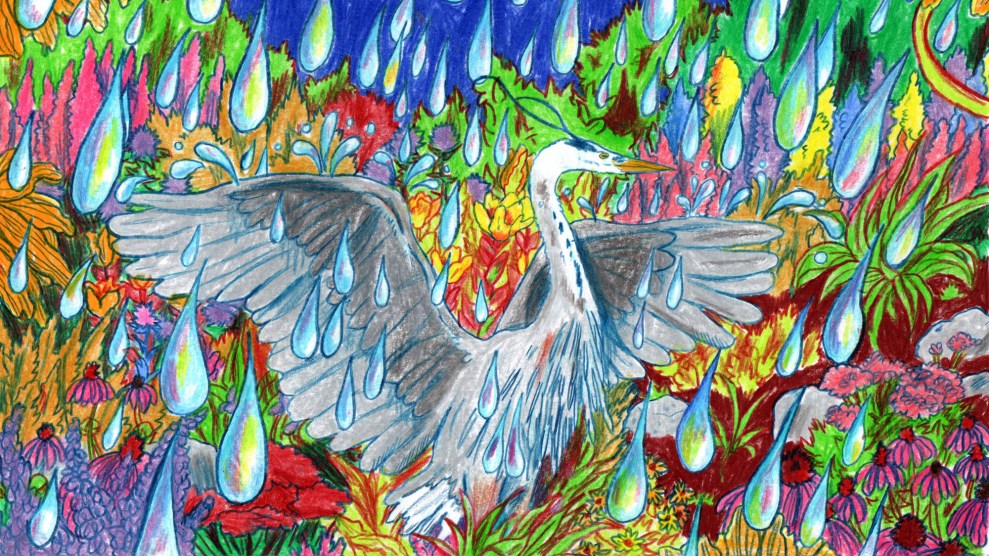
Hannah Lock
In 2021, on San Francisco’s wettest October day on record, an “atmospheric river” dumped a stunning 4.02 inches of rain downtown, causing highways and neighborhoods in the area to flood. Cars were stranded in standing water. And the city’s sewers, which carry both stormwater and sewage, overflowed in the low-lying Marina neighborhood. Officials estimated that 1.4 million gallons of untreated water could have escaped into the bay. For the approximately 700 municipalities in the United States with combined sewers, overflow can happen during periods of heavy rainfall and can lead to polluted waterways, closed beaches, and tainted drinking water. And with climate change, heavier storms are on the horizon. So about 10 years ago, San Francisco began to turn, in part, to a simple solution: planting dozens of public rain gardens.
At the most basic level, rain gardens function like sponges. They are typically made by digging 5 or so feet into the ground, adding layers of rock and soil mixes designed to absorb and filter water, and topping the layers with flowers, trees, and shrubs. A finished rain garden should dip like a bowl about half a foot below ground level so that when it rains, the garden can temporarily fill up, allowing water to percolate into the ground rather than run into the street.
And, research shows, the gardens are remarkably effective at capturing runoff. When San Francisco’s Public Utilities Commission, for instance, installed 30 new rain gardens along a 12-block strip in the city’s Outer Sunset neighborhood, the corridor reduced the amount of stormwater entering the sewer by 95 percent for the area, taking in about 6 million gallons—more than the volume of the iconic Lincoln Memorial reflecting pool in Washington, DC—per year. On a smaller scale, individual homeowners who install rain gardens to collect runoff from roofs and gutters can expect to soak up an estimated 30 percent more water than they would with grass lawns.
Plus, rain gardens, which often include low-maintenance native plants, offer a wealth of other benefits. “Some people think of rain gardens as just kind of glorified ditches,” said Jennifer Cooper, who manages the Landscape Architecture Bureau for San Francisco Public Works. “But they can be more.” They’re commonly used to filter runoff pollution, and they can also reduce urban heat, offer habitats for pollinators, and serve as scenic gathering spaces for people.
Cooper and her colleagues designed one of the Outer Sunset rain gardens to double as an outdoor classroom. Situated across from St. Ignatius College Preparatory high school, the 1,200-square-foot garden is shaped like a kidney bean and is full of Cleveland sage, yarrow, coyote brush, sticky monkey-flower, toyon, and rosemary. It includes four rows of benches, a handful of boulders, and as Cooper pointed out to me when I visited in October, stepping stones made from recycled granite street curbs. (Wildlife seem to like the place, too—my rain garden tour was punctuated by a visit from a blue heron.)
San Francisco is far from the first place to collect its rain. Portland and Seattle were among the first cities in the United States to adopt rain gardens and other water-absorbing features like green roofs and permeable pavement, which allows water to seep through it rather than pooling on top. Today, cities around the world, including in Denmark, Poland, Singapore, and Brazil, among others, are incorporating rain gardens into their urban landscapes.
But convincing city officials to choose green infrastructure over more traditional, “gray” technology, like concrete pipes, hasn’t come without challenges. Rain gardens require green space, which may be limited in dense urban areas, and workers often need special training to maintain them. Plus, they can look a bit unconventional: Native shrubs planted in a hollow ditch aren’t exactly the pristine, manicured look desired by some people. Many of the experts I spoke with said a major hurdle is the task of convincing planners to embrace a new way of thinking. Even with “very strong” data supporting rain gardens’ benefits, the default among regulators, designers, and engineers is often traditional drainage pipes, according to Brendan Shane, the climate director for the Trust for Public Land, a national non-profit aimed at expanding access to nature.
As climate change brings increasingly heavy rain, cities would be wise to suck it up. Consider: Two months before San Francisco’s heavy rain event in October 2021, New York City issued its first-ever flash flood emergency warning. The storm killed at least 13 people in the city, mostly in flooded basements, in part because, given that nearly three-quarters of the city’s surfaces are made of impervious material like concrete, the water had few places to go. In July 2022, St. Louis saw record-breaking rains, and days later, floods in Kentucky killed dozens of residents.
Major flooding events also occurred last summer in Las Vegas, Arizona, and Texas. In fact, heavy rain events have increased in much of the country since 1958, according to a 2018 federal climate report, with the biggest increases in the Northeast, by 55 percent, and the Midwest, by 42 percent. Often, it’s low-income communities of color, where decades of underinvestment means greenery is scant, that suffer disproportionately from these events. According to a 2021 analysis of 38 major US cities, for instance, formerly red-lined neighborhoods have 25 percent more homes at risk of flooding than nonredlined, mostly white neighborhoods.
Rain gardens, of course, are only part of the solution; a 10-foot-wide depression in the ground won’t solve, say, the drivers of climate change or environmental racism, and it can’t on its own protect us from megastorms. The good news is that, for cities able to dig for it, money for green public works is available. In addition to the billions of dollars in existing funding options with the Environmental Protection Agency, Congress’ Bipartisan Infrastructure Law includes more than $50 billion for water-related projects, while the 2022 Inflation Reduction Act includes $2.8 billion in funding to help underserved communities become more climate resilient. While grants are up to individual agencies to award, said Lydia Olander, director of nature-based resilience at the White House Council on Environmental Quality, “there are a number of places” where rain gardens could fit under both new laws.
Individual homeowners can make a difference, too. For those who want to add a rain garden to their yard, the EPA recommends looking for reimbursement programs through local and state public works offices. With city funding, for instance, the Trust for Public Land’s Shane paid “almost nothing” to put a rain garden capable of holding several hundred gallons of water in his own backyard in 2022. It’s one of at least 4,000 properties DC has souped up with rain gardens, rain barrels, permeable pavement, or other green projects in the past decade or so. “Each one is small, but when you add them up,” he said, “you start to see really big impacts on the volume of runoff, on the quality of water.”
Learn how to install and fund a rain garden on this rain garden resources page.














